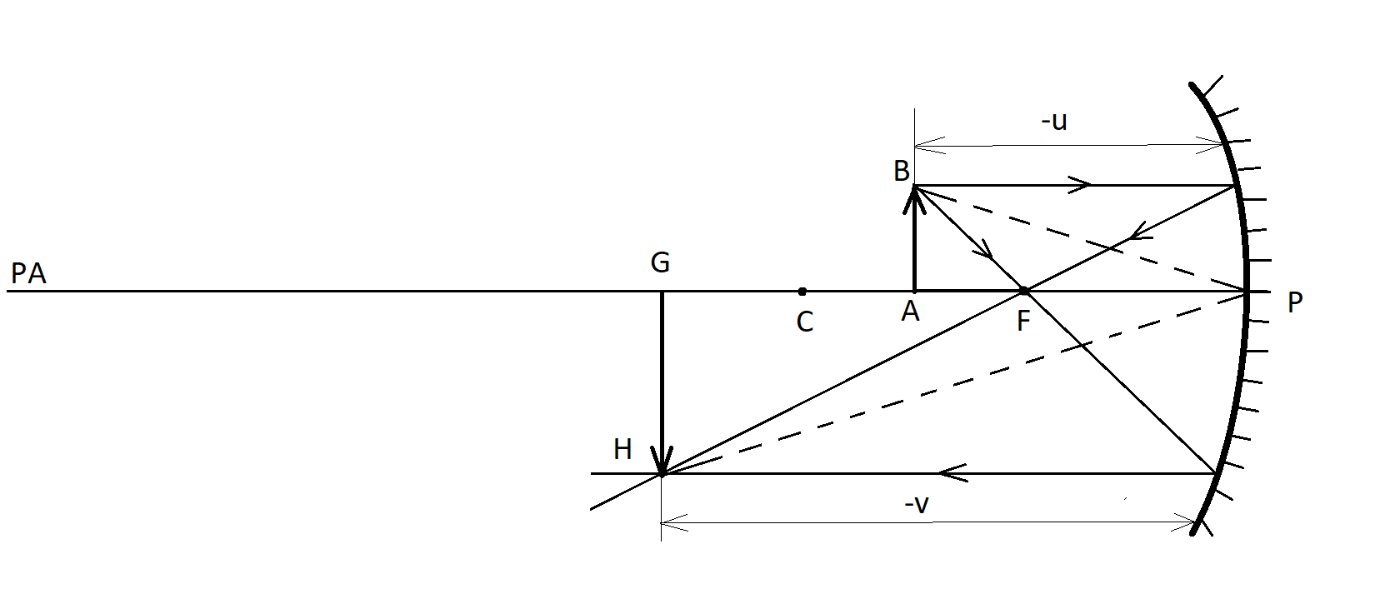
The magnification for a mirror is -3. How are u and v related?
Answer
219.3k+ views
Hint: Before we understand the concept of magnification in a mirror, it is important to understand the magnification is only possible in curved mirrors. In plane mirrors, the magnification is always 1 which means that the image is not enlarged or diminished in a plane mirror and always has the same size of the object. Hence, we have to consider curved mirrors only.
Complete step by step answer:
Magnification of the image is defined as the ratio of height of the image produced by the curved mirror to the ratio of height of the object.
Let us consider an object AB of height ${h_0}$ and distance -u from the pole P placed between centre of curvature C and focus F in front of a concave mirror as shown:

There are two rays emerging from the object.
i) First ray, parallel to the principal axis PA, after reflection, passes through focus.
ii) Second ray, passing through focus, after reflection, passes parallel to the principal axis.
These two rays meet beyond the centre of curvature C, to form the image GH of height ${h_i}$ at distance of -v from the pole.
Consider the triangles ABP and GHP.
$\Rightarrow \angle PAB = \angle PGH = {90^ \circ }$
By the law of reflection that incident angle equal to reflected angle, we have –
$\Rightarrow \angle APB = \angle GPH$
Hence, we can prove that the triangles ABP and GHP are similar.
By rule of similarity, we can say that –
$\Rightarrow \dfrac{{GH}}{{AB}} = \dfrac{{\left( { - v} \right)}}{{\left( { - u} \right)}}$
$ \Rightarrow \dfrac{{GH}}{{AB}} = \dfrac{v}{u}$
Given that $AB = {h_0}$ and $GH = - {h_i}$ (the negative sign is because the height of image is measured downwards direction)
Magnification is equal to the ratio of height of image of height of object.
$\Rightarrow m = \dfrac{{ - {h_i}}}{{{h_0}}}$
Substituting,
$\Rightarrow m = - \dfrac{v}{u}$
Therefore, magnification is defined as the ratio of v to u with a minus sign.
Note: The formula for the magnification in a lens is the same as that of a mirror, but only in the magnitude. The magnification formula for lenses has a positive sign while the magnification formula for a mirror has a negative sign.
Magnification for lens –
$m = \dfrac{v}{u}$
The students must understand the clear distinction between the two so that there is no confusion between the two formulae.
Complete step by step answer:
Magnification of the image is defined as the ratio of height of the image produced by the curved mirror to the ratio of height of the object.
Let us consider an object AB of height ${h_0}$ and distance -u from the pole P placed between centre of curvature C and focus F in front of a concave mirror as shown:

There are two rays emerging from the object.
i) First ray, parallel to the principal axis PA, after reflection, passes through focus.
ii) Second ray, passing through focus, after reflection, passes parallel to the principal axis.
These two rays meet beyond the centre of curvature C, to form the image GH of height ${h_i}$ at distance of -v from the pole.
Consider the triangles ABP and GHP.
$\Rightarrow \angle PAB = \angle PGH = {90^ \circ }$
By the law of reflection that incident angle equal to reflected angle, we have –
$\Rightarrow \angle APB = \angle GPH$
Hence, we can prove that the triangles ABP and GHP are similar.
By rule of similarity, we can say that –
$\Rightarrow \dfrac{{GH}}{{AB}} = \dfrac{{\left( { - v} \right)}}{{\left( { - u} \right)}}$
$ \Rightarrow \dfrac{{GH}}{{AB}} = \dfrac{v}{u}$
Given that $AB = {h_0}$ and $GH = - {h_i}$ (the negative sign is because the height of image is measured downwards direction)
Magnification is equal to the ratio of height of image of height of object.
$\Rightarrow m = \dfrac{{ - {h_i}}}{{{h_0}}}$
Substituting,
$\Rightarrow m = - \dfrac{v}{u}$
Therefore, magnification is defined as the ratio of v to u with a minus sign.
Note: The formula for the magnification in a lens is the same as that of a mirror, but only in the magnitude. The magnification formula for lenses has a positive sign while the magnification formula for a mirror has a negative sign.
Magnification for lens –
$m = \dfrac{v}{u}$
The students must understand the clear distinction between the two so that there is no confusion between the two formulae.
Recently Updated Pages
A square frame of side 10 cm and a long straight wire class 12 physics JEE_Main

The work done in slowly moving an electron of charge class 12 physics JEE_Main

Two identical charged spheres suspended from a common class 12 physics JEE_Main

According to Bohrs theory the timeaveraged magnetic class 12 physics JEE_Main

ill in the blanks Pure tungsten has A Low resistivity class 12 physics JEE_Main

The value of the resistor RS needed in the DC voltage class 12 physics JEE_Main

Trending doubts
JEE Main 2026: Application Form Open, Exam Dates, Syllabus, Eligibility & Question Papers

Understanding Uniform Acceleration in Physics

Derivation of Equation of Trajectory Explained for Students

Hybridisation in Chemistry – Concept, Types & Applications

Understanding the Angle of Deviation in a Prism

Understanding Collisions: Types and Examples for Students

Other Pages
JEE Advanced Marks vs Ranks 2025: Understanding Category-wise Qualifying Marks and Previous Year Cut-offs

Understanding Atomic Structure for Beginners

How to Convert a Galvanometer into an Ammeter or Voltmeter

Understanding Centrifugal Force in Physics

JEE Main Marking Scheme 2026- Paper-Wise Marks Distribution and Negative Marking Details

Degree of Dissociation: Meaning, Formula, Calculation & Uses




